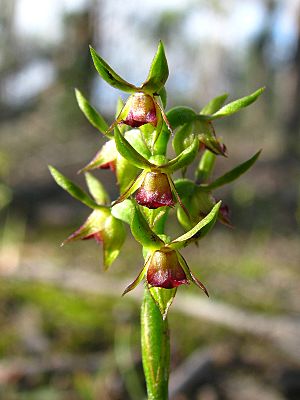Corunastylis ciliata facts for kids
Quick facts for kids Fringed midge orchid |
|
|---|---|
 |
|
| Scientific classification | |
| Genus: |
Corunastylis
|
| Species: |
ciliata
|
| Synonyms | |
|
Prasophyllum ciliatum Ewart & B.Rees |
|
The Fringed Midge Orchid (scientific name: Corunastylis ciliata) is a tiny orchid that grows only in southern Australia. It has one thin leaf that is joined to its flower stem. This orchid can have up to fifteen small flowers. These flowers are usually green or yellowish-green with purple marks. They also have a special reddish-purple part called a labellum.
Scientists used to think this orchid was the same as another one, Corunastylis archeri. However, C. ciliata has fewer flowers that stand up straighter. Its labellum is also less hairy, and its colors are different from C. archeri.
Contents
What the Fringed Midge Orchid Looks Like
The Fringed Midge Orchid is a perennial plant, meaning it lives for more than two years. It is also a deciduous herb, which means its leaves fall off at certain times. This orchid grows from a special underground part called a tuber.
Its Leaf and Stem
Each plant has a single thin leaf. This leaf is about 50 to 130 millimeters (2 to 5 inches) long. Part of the leaf is joined to the flowering stem. The free part of the leaf, which sticks out, is about 6 to 13 millimeters (0.2 to 0.5 inches) long.
Its Flowers
The orchid's flowers grow on a stem that is 5 to 30 millimeters (0.2 to 1.2 inches) tall. This stem is usually taller than the leaf. Up to fifteen flowers can be found close together on the stem. Each flower is about 8 millimeters (0.3 inches) long and 5 millimeters (0.2 inches) wide. They are green to yellowish-green with light purple markings.
Just like other orchids in its genus Corunastylis, these flowers are upside down. This means their labellum is above the column instead of below it.
Flower Parts
- The dorsal sepal (the top part) is shaped like an egg. It is about 4 millimeters (0.2 inches) long and 2.5 millimeters (0.1 inches) wide.
- The lateral sepals (the side parts) are long and narrow. They are about 5 millimeters (0.2 inches) long and 1 millimeter (0.04 inches) wide. These sepals spread apart from each other.
- The petals are also long and narrow, or shaped like small eggs. They are about 4 millimeters (0.2 inches) long and 1.5 millimeters (0.06 inches) wide. Their edges are smooth, and they have a pointed tip.
- The labellum is a wide, oval-shaped part. It is 3 to 4 millimeters (0.1 to 0.2 inches) long and 2 to 3 millimeters (0.08 to 0.1 inches) wide. The edges of the labellum have tiny hairs, up to 0.5 millimeters (0.02 inches) long.
- There is also a raised part called a callus in the middle of the labellum. It is shaped like a cone and reaches almost to the tip of the labellum.
This orchid usually blooms between February and April.
How it Got its Name
The Fringed Midge Orchid was first officially described in 1912. Two scientists, Alfred Ewart and Bertha Rees, wrote about it. Their description was published in a science journal called the Proceedings of the Royal Society of Victoria.
Later, in 1989, two other scientists, David Jones and Mark Clements, changed its scientific name to Corunastylis ciliata. The second part of its name, ciliata, comes from a Latin word cilium. This word means "eyelash," which probably refers to the tiny hairs on the orchid's labellum.
Where the Fringed Midge Orchid Lives
You can find Corunastylis ciliata growing in different types of places. It likes heathlands, grassy woodlands, and heathy forests.
In Victoria, it mostly grows west of Wilsons Promontory. In South Australia, it prefers wet areas near swamps. You can find it in places like Mount Compass and Mount Gambier.

